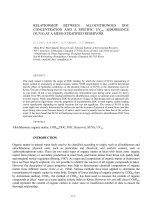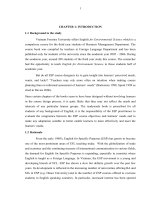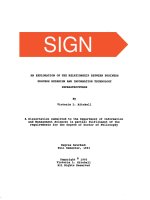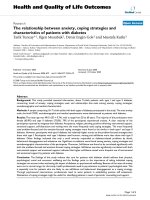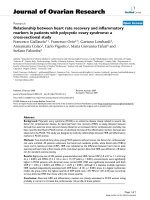Relationship between business process improvement and customer satisfaction at vietnam international bank (VIB bank)
Bạn đang xem bản rút gọn của tài liệu. Xem và tải ngay bản đầy đủ của tài liệu tại đây (1.84 MB, 87 trang )
ĐẠI HỌC QUỐC GIA HÀ NỘI
KHOA QUẢN TRỊ VÀ KINH DOANH
---------------------
NGUYỄN THANH HÀ
RELATIONSHIP BETWEEN BUSINESS PROCESS
IMPROVEMENT AND CUSTOMER SATISFACTION AT
VIB BRANCH
MỐI QUAN HỆ GIỮA CẢI TIẾN QUY TRÌNH KINH DOANH VỚI SỰ
HÀI LÒNG CỦA KHÁCH HÀNG TẠI CÁC CHI NHÁNH NGÂN
HÀNG QUỐC TẾ (VIB)
LUẬN VĂN THẠC SĨ QUẢN TRỊ KINH DOANH
HÀ NỘI - 2018
ĐẠI HỌC QUỐC GIA HÀ NỘI
KHOA QUẢN TRỊ VÀ KINH DOANH
---------------------
NGUYỄN THANH HÀ
RELATIONSHIP BETWEEN BUSINESS PROCESS
IMPROVEMENT AND CUSTOMER SATISFACTION AT
VIB BRANCH
MỐI QUAN HỆ GIỮA CẢI TIẾN QUY TRÌNH KINH DOANH VỚI SỰ
HÀI LÒNG CỦA KHÁCH HÀNG TẠI CÁC CHI NHÁNH NGÂN
HÀNG QUỐC TẾ (VIB)
Chuyên ngành: Quản trị kinh doanh
Mã số: 60 34 01 02
LUẬN VĂN THẠC SĨ QUẢN TRỊ KINH DOANH
NGƯỜI HƯỚNG DẪN KHOA HỌC: TS. TRẦN HUY PHƯƠNG
Hà Nội - 2018
DECLARATION
The author confirms that the research outcome in the thesis is the result
of author’s independent work during study and research period and it is not
yet published in other’s research and article.
The other’s research result and documentation (extraction, table, figure,
formula,and other document) used in the thesis are cited properly and the
permission (if required) is given.
The author is responsible in front of the Thesis Assessment Committee,
Hanoi School of Business and Management, and the laws for abovementioned declaration.
Date: Jan, 2018
ACKNOWLEDGEMENT
I have gained huge knowledge, skill and insights from my MBA
course. The course raises my capacity of administration and management up
to the next level. I am now very confident in my position of management. I
would like to extend my sincerest thanks and appreciation to all those who
have made this Thesis to be possible.
I woud like to express my great gratitude to my supervisor Ph.D Tran
Huy Phuongfor her useful comments, remarks and engagement during my
process of doing this master thesis. Also, I would like to give my sincere
thanks tocustomers of VIB, in my survey, who have willingly spent their
precious time joining the interview.
Sincere thanks are extended to the Faculty of International Training Vietnam National University, Hanoi for equipping me with huge knowledge
and skills through various interesting and practical subjects. I also would like
to thanks my classmates for their friendship and reciprocal encouragement to
make our class time to be unforgettable time
Lastly, I would like to give my great thanks to my family who always
standby me during the past two years and encourages me to keep moving
from the beginning of my study.
TABLE OF CONTENTS
LIST OF TABLES ............................................................................................. i
LIST OF FIGURES AND CHARTS ................................................................ ii
INTRODUCTION ............................................................................................. 1
1. Background to the study................................................................................ 1
2. Statement of the problem .............................................................................. 2
3. Objectives of the study .................................................................................. 4
4. Research questions ........................................................................................ 4
5. Significance of the study ............................................................................... 4
6. Overview of research methodology .............................................................. 5
6.1 Data collection............................................................................................. 5
6.2 Data analysis method ................................................................................. 6
7. Scope of the study ......................................................................................... 7
8. Structure of thesis .......................................................................................... 7
Chapter 1: THEORETICAL FRAMEWORK ON CUSTOMER SERVICE
PROCEDURES AND CUSTOMER SATISFACTION AT COMMERCIAL
BANKS ............................................................................................................. 9
1.1 Research overview ...................................................................................... 9
1.2 Basic concepts ........................................................................................... 12
1.2.1 Customer ................................................................................................ 12
1.2.2 Customer service .................................................................................... 13
1.2.3 Procedures of customer service.............................................................. 13
1.2.4 Customer satisfaction ............................................................................. 14
1.3 Role and characteristics of customer service procedures ......................... 14
1.3.1 Role of customer service procedures ..................................................... 14
1.3.2 Characteristics of customer service procedures ..................................... 15
1.4 Relationship between customer service procedures and customer
satisfaction ....................................................................................................... 16
1.5 Influence of factors of customer service procedures on customer
satisfaction ....................................................................................................... 17
1.5.1 Time of procedure implementation ........................................................ 17
1.5.2 Human resources in procedure implementation .................................... 18
1.5.3 Convenience of procedures .................................................................... 19
1.5.4 Safety in procedure implementation ...................................................... 19
1.5.5 Flexibility in procedure implementation ................................................ 20
1.6 Experience in designing customer service procedures to improve customer
satisfaction at some commercial banks ........................................................... 21
1.6.1 Experience of BIDV ............................................................................... 21
1.6.2 Experience of Vietcombank ................................................................... 23
1.6.3 Experience lessons for VIB.................................................................... 26
Chapter 2: REALITY OF CUSTOMER SATISFACTION TOWARD
PROCEDURES FOR CREDIT AND CREDIT CARD GRANTING
SERVICES ...................................................................................................... 27
2.1 Overview of Vietnam International Commercial Joint Stock Bank ......... 27
2.1.1 The formation and development process ............................................... 27
2.1.2 Business mission and function ............................................................... 29
2.1.3 Organizational structure ......................................................................... 30
2.1.4 Distribution system ................................................................................ 30
2.1.5 The results of the banking business ....................................................... 31
2.2 Reality of customer satisfaction toward procedures for credit and credit
card granting services ...................................................................................... 32
2.2.1 Overview of procedures for credit and credit card granting services .... 32
2.2.2 Analysis of factors affecting procedures for credit and credit card
granting services .............................................................................................. 45
2.3 VIB General assessment of credit and credit card granting procedures at
VIB .................................................................................................................. 56
2.3.1 Factors making customers satisfied ....................................................... 57
2.3.2 Factors making customers dissatisfied ................................................... 57
2.3.3 Causes of factors making customers dissatisfied ................................... 58
Chapter
3:
SOLUTIONS
TO
IMPROVE
CUSTOMER
SERVICE
PROCEDURES TO ENHANCE CUSTOMER SATISFACTION AT VIB . 60
3.1 Development orientation of VIB............................................................... 60
3.1.1 General development orientation ........................................................... 60
3.1.2 Development orientation of credit and credit card services at VIB ....... 61
3.2 Solutions to improve credit and credit card procedures to enhance
customer satisfaction at VIB ........................................................................... 63
3.2.1 Specific solutions ................................................................................... 63
3.2.2 Supporting solutions............................................................................... 66
CONCLUSION AND RECOMMENDATIONS ........................................... 72
REFERENCES ................................................................................................ 74
APPENDIX ..................................................................................................... 76
LIST OF TABLES
Table 1: No. of survey’s responses for required competencies ........................ 6
Table 2.1: Business results of Vietnam International Commercial Joint Stock
Bank................................................................................................................. 31
Table 2.2 Lending process description ........................................................... 36
Table 2.3: Credit card process description ...................................................... 42
Table 2.4: Assessment of customer on time service performance .................. 47
Table 2.5: Activity of training of human resources at VIB ............................ 49
Table 2.6: Assessment of clients in human resources at VIB ......................... 50
Table 2.7: Customer reviews of convenience ................................................. 52
Table 2.8: Customer evaluations of safety ...................................................... 54
Table 2.9: Customer reviews of flexibility ..................................................... 55
i
LIST OF FIGURES AND CHARTS
Chart 1.1: The process of credit services deployed in BIDV ......................... 22
Chart 1.2: The process of implementing the credit card service in BIDV ..... 23
Chart 1.3: The process of credit services deployed at Vietcombank .............. 26
Figure 2.1: Organizational structure of VIB ................................................... 30
Process 2.1: Current Lending Procedure. Part A. Generate Leads & Perform
Sales................................................................................................................. 34
Process 2.2: Current Lending Procedure. Part B. Manage Originations ........ 35
Process 2.3: Current Lending Procedure. Part C. Process Contract; Process
Collateral; Disburse Fund ............................................................................... 35
Process 2.4: Current credit card granting procedure. Part A. Generate Leads &
Perform Sales .................................................................................................. 40
Process 2.5: Current credit card granting procedure. Part B. Manage
Originations ..................................................................................................... 41
Process 2.6: Current credit card granting procedure. Part C. Process Contract,
Perform Collateral; Disburse Fund ................................................................. 41
Figure 2.2: Average transaction processing time ............................................ 46
ii
INTRODUCTION
1. Background to the study
Customer service is the provision of service to customers before,
during and after a purchase. Everyone in the organization is providing
one or all of these- perhaps they recognize which ones perhaps not.
Kurtenbach (2000) explains that those who are successful in customer service
rank their customers experience as the top priority. Ettore (2001) is of the
view that, concentrating on current customer’s information can and should be
obtained to better understand their view of the service provided. The quality
of service provided determines the level of satisfaction of the customer even
though what is seen as quality by one customer may not necessarily be quality
to another. Customer satisfaction is a measure of how products and services
supplied by a company meet or surpass customer expectation.
In
a
competitive marketplace where a business competes for customers,
customer satisfaction is seen as a key differentiator and increasingly has
become a key element of business strategy. Customer satisfaction is an asset
that should be monitored and managed just like any physical asset. The
relationship between customer service and customer satisfaction is a vital one.
1
According to Deloitte research, it is stated that loyalty mainly comes
from customer service, not from products & services as many people thought.
Customer service holds the key to deeper long-term relationships.
It is therefore companies and banks in this case, have moved from
product-centric to customer-centric positions. Customer satisfaction is
influenced by the type of services provided. Satisfaction is a challenge
particularly in the bank based -service as customers can easily switch from
one bank to another one of better service. It is very significant to find out
what makes customer satisfy and loyal to a company. VIB bank, has customer
service as one of the most priorities on which the bank operates and this
research seeks to find out whether the service being provided meets
customer expectations and whether customers are being satisfied by those
services and also which other ways the service can be improved so as to
satisfy the customers.
2. Statement of the problem
Achieving growth in retail banking is becoming increasingly difficult.
Industry-wide, mortgage and deposit revenues are declining and credit card
growth is stagnant. The ever shrinking share of the market is split between
more and more sources of competition.
Beginning in the late 2015s, almost banks and credit institutions began
offering banking traditional and tech-based services, leading to greater price
and technology competition — a trend that has continued. For example, retail
VP bank, long noted for putting the squeeze on its competitors through live
chat which very modern to Vietnam market and convenient to customers who
used to familiar with traditional channels. Other traditional competitors, such
as FE Credit, have leveraged their lower, simpler cost and quick approval to
their advantage by offering customers very attractive deposit products at
2
aggressive rates, and a wide range of lending products at typically lower
interest rates.
According to Deloitte, survey of banking executives 2017, as a result of
this success, leading drivers of loyalty are customer service quality. The
reported cited that it accounts up to 50% if the brands offers best quality
product and services, 41% for outstanding customer service
Banks are having trouble fully the potential strategic value of their
interactive branch. The result is that banks cannot execute on the goals of the
company as a whole — such as creating a great customer experience, cross-
3
selling and up-selling more products and services and increasing agent
productivity and satisfaction.
3. Objectives of the study
Theoretical framework for customer service procedures, customer
satisfaction and the relationship between customer processes and procedures
with customer satisfaction.
Analyzing, assessing customer satisfaction with the process of credit,
credit card at VIB
Proposed solutions to improve the process, customer service procedures
to improve customer satisfaction with VIB
4. Research questions
1. How is current state process?
2. What are dominant transactions and how long is processing time?
3. Does the service quality have any effect on customer satisfaction?
4. How services can be improved in the branch of bank?
5. Significance of the study
VIB bank has customer service as one of its products, hence the
need to find out whether they really are providing that service and what
ways they can improve so as to have competitive advantage over rivals in the
market.
This work will therefore provide information regarding excellent
customer service and its effects on customer satisfaction in the Vietnam
context. Furthermore, current status of customer service is analyzed based on
figures and statistic.
4
This piece will be available to the bank being researched for the
management to know the perception of their customers on services being
provided to them and to help improve on service quality.
Educational institutions, corporate entities, business policy makers and
other researchers will also benefit from this research in making informed
decisions
when
it
comes
to quality customer service to satisfy the
customers.
6. Overview of research methodology
6.1 Data collection
The thesis uses both secondary data and primary data to find out
satisfaction of customers by VIB proceses, regulations and procedures.
Secondary data: The secondary data were collected from the following
resources:
- From documents, reports, policies, stage of lending processs: Lending
Process, Credit Card Process of VIB
- Other articles on newspapers, journals, books, magazines related to
factors affecting Lending Process, Credit Card Process of VIB.
Primary data: The primary data were collected from two methods of
in-depth interview and survey.
- In-depth interview:
With the qualitative method, in-depth interviews were conducted with
relevant and experienced senior managers at VIB Head Office as follows to
collect their opinions and comments.
+ Interviewees: senior managers at VIB Head Office including the
three followings:
* Mr. Dang Khac Vy – Chairman of the Board of Directors of VIB
* Mr. Tran Nhat Minh – Deputy General Director of VIB
* Mrs. Nguyen Hoang Hai – Head ofCorporate Transformation Center
5
+ Sample size: 3
+ Interviewing method: The researcher held a meeting to interview
them directly. During the interview, the researcher gave questions based on
listed or prepared questions. Based on their opinions and comments, the
researcher collected and took note for information.
+ Objective of in-depth interview: In order to understand more about the
VIB’s information, some barriers to branch by VIB proceses, regulations and
procedures, recommend improvements should be made to enhance customer
service
- Survey:
* Respondents: 200 customers, who have been using the service lending
process, credit card process of VIB in Ha Noi.
* Questionnaire design: Based on factors that affect customer
satisfaction on service lending process, credit card process of VIB. The
questionnaire for custommers were designed into two main sections. The
questionnaires start with a general guidance for the survey. Then respondents
move to personal information and assessment towards the research topic.
Therefore, custommers made assessment for lending process, credit card
process of VIB. The questionnaire will be emailed to each customer.
The number of survey’s responses obtained are as follows:
Table 1: No. of survey’s responses for required competencies
Planned
No.
Respondent
Actual response
%
1
Individual customers
150
150
100%
2
Corporate customers
50
50
100%
3
Total
200
200
100%
response
Source: Primary data (2016)
6.2 Data analysis method
6
Both of interviews and survey of questionnaire’s data were analyzed
using table, graph, and comparison. On the other hand, it was effectively to
use descriptive statistics in the study due to this analysis, which is the most
common and fundamental data analysis in academic studies, including such as
percentage (%), frequency (f) and means.
Furthermore, the Researcher used Excel software as tool to carry
descriptive statistics as well as drawing table and graphs. Using percentage
(%), frequency (f) and means is that if an element has a low means, it means
that the element is weak and needs to be improved
From those analyzed data, it was able to draw some results. Based on
them, it was possible to formulate some conclusions and solutions to to
enhance customer satisfaction on service processes and procedures at VIB.
7. Scope of the study
- Research subjects: Process of credit, credit card at VIB
- Space: study done at VIB
- About time: study conducted in the period 2014-2016
8. Structure of thesis
The thesis is started with the Introduction and ending by the
Conclusion. The main contents of this thesis are divided into three chapters as
following:
Chapter 1: THEORETICAL FRAMEWORK ON CUSTOMER
SERVICE
PROCEDURES,
CUSTOMER
SATISFACTION
AND
RELATIONSHIP BETWEEN CUSTOMER SERVICE PROCEDURES
AND CUSTOMER SATISFACTION
7
Chapter 2: REALITY OF CUSTOMER SATISFACTION TOWARD
PROCEDURES FOR CREDIT AND CREDIT CARD GRANTING
SERVICES
Chapter 3: SOLUTIONS TO IMPROVE PROCEDURES FOR
CREDIT AND CREDIT CARD GRANTING SERVICES TO ENHANCE
CUSTOMER SATISFACTION AT VIB
8
Chapter 1: THEORETICAL FRAMEWORK ON CUSTOMER
SERVICE PROCEDURES, CUSTOMER SATISFACTION AND
RELATIONSHIP BETWEEN CUSTOMER SERVICE PROCEDURES
AND CUSTOMER SATISFACTION
1.1 Research overview
On conducting the research, the author found several published works
related to the topic as follows:
The study by Adams B. Steven, Yan Dong and Martin Dresner (2012) on
―Linkages between customer service, customer satisfaction and performance
in the airline industry: Investigation of non-linearities and moderating
effects‖: In the study, the authors presented the relationship between customer
service and customer satisfaction andthe relationship between customer
satisfaction and performance of organizations operating in the aviation
industry in the United States. The results showed that there was a correlation
between customer service factors, customer satisfaction and performance of
the organizations. In addition, the study highlighted the importance of
deploying customer services to the profitability and returns of airline
companies. In general, the research made a great contribution to the
development of American aviation companies. However, the research only
mentioned the relationship between customer service and customer
satisfaction without clarifying the relationship between service procedures
andsatisfaction of customers using the services.
The study by Olowokudejo and Adeleke (2011) on "The relationship
between customer focused service and customer satisfaction in Nigerian
insurance industry":This study was carried out to find out the relationship
between customer service and customer satisfaction in the insurance industry
in Nigeria. Relevant literature was reviewed and a model of four variables
9
was tested by empirical data collected from an experimental survey. The
sample size of the survey included 180 modern clients using the services of
insurance companies. 149 questionnaires were fully completed and valid.
Correlation analysis, regression analysis,and Cronbach Alpha coefficient were
used to test the research model. The results revealed that there was a positive
relationship between customer focused service and customer satisfaction in
the insurance industry in Nigeria. The study also showed that attractive
customer service would lead to satisfaction of customersofinsurances
companies. Based on the research results, the authors recommended that
insurance companies should pay more attention to product design and
customer-focused services.
The study by Enyonam Afi Ako-Nai (2011) on "Effect of customer
service on customer satisfaction - A case study of Fidelity Bank, Adum,
Kumasi": The purpose of the study was to find out whether the customer
service influenced the satisfaction of customers using banking services. The
main research method used in this study was a case study involving the
Fidelity branch. Questionnaires were used to collect information from
customers and staffs of the bank. The results of the research showed that
Fidelity Bank - Adum Branch paid much attention on improving customer
service but had not satisfied customers. Some remarkable limitations in
customer service includedineffective online banking and unreasonable
management decisions. From the research results, the author proposed a
number of solutions such as increasing the number of bank staffs,increasing
utilities of products and services to better satisfy the needs of customers.
Although the research contributed greatly to the development of Fidelity
banking system,it did not mention the service procedures of the bank.
The study by Krishna, Jacob Alexander and Mihir Dash (2012) on
"Basic customer service and its impact on customer retention":This research
10
was carried out to find out the relationship between basic customer service
and customer loyalty. The study was based on the primary data collected from
a survey with 142 business organizations in Bangalore, India. The research
pointed out that in order to improve customer satisfaction and retain
customers to organizations, organizations needed to regularly review the
customer complaints and provide full and timely information to customers
about the situation of theircomplaints to improve customer service. However,
the research had a number of typical limitations: The sample size used in the
study was relatively small; companies providedinconsistent samples. At the
same time, the researchwas generallyconducted and did not focus on a
particular industry, so the results were difficult to be applied.
The research by Bui Thi Trang (2017) on "Impact of customer service
quality on customer satisfaction at Vietravel Ha Hoi Tourism Company": The
study was conducted in 2 phases. Preliminary research was conducted by
discussions with five experts from service providers with large market shares
including Vietravel, Hanoitourist and Redtour. In addition, in-depth
discussions and interviews were also conducted with a group of 10 regular
customers using the company's products and services and a preliminary
survey was carried out with 30 clients. The formal study was conducted by
means of quantitative research as soon as the questionnaire was modified
from the results of the preliminary study (formal interview questionnaire) to
to collect survey data. The results showed that the convenience and reliability
in customer service quality had the greatest impact on customer satisfaction.
From the research results, the author proposed some solutions to improve
customer satisfaction such as improving customer care activities,creating
good image in customer's mind, diversifying marketing strategies and
enhancing convenience and safety of products and services. The research
11
ensured high reliability, but it only evaluated the quality of services without
considering the influence of service procedures on customer satisfaction.
Through the study of published researches, the author found that
although there were many studies on customer satisfaction, no studied
investigated the impact of customer service procedures on customer
satisfaction. Therefore, to fill the research gap, the author conducted the
research entitled "Improving customer service procedures to enhance
customer satisfaction -A case study at VIB". During the course of the
research, the author would accomplish the following objectives:
- Synthesizing the theoretical frameworkon customer service procedures;
clarifying the relationship between customer service procedures and customer
satisfaction.
- Evaluating the reality of service procedures at VIB (evaluating the
procedures for granting credit and credit cards in detail);conductingsurvey
with customers on service procedures of VIB.
- Proposing a system of new procedures for the implementation of credit
and credit card services and a number of supporting solutions to improve
customer satisfaction.
1.2Basic concepts
1.2.1 Customer
Customers could best be described as those who use the output of work,
the end users of products or services. They may be internal to the organization
such as the employees and directors or external like members of the public,
other businesses, or government (DeiTumi, 2005).A customer is a person who
buys goods or services from the service provider. It may also refer to any
potential buyer.
The word "custom" means "habit", a person who goes to a store on a
frequent basis to purchase their products or services, thus it is their habit to
12
buy from that particular store. In the opinion of Peter Drucker, there are now a
complete new breed of customers with high standards and expectations (DeiTumi, 2005). And as competition increases, there is the need to devise
creative and new ways of meeting the ever-increasing demands of the
modern-
day
customer
who
is
very sophisticated,
knowledgeable,
demands excellent products and services and has alternatives.
1.2.2 Customer service
Customer service is an organization's ability to supply their customers'
wants and needs ().
Customer service is the provision of service to customers before, during
and after a purchase. The perception of success of such interactions is
dependent on employees "who can adjust themselves to the personality of the
guest".[1] Customer service concerns the priority an organization assigns to
customer service relative to components such as product innovation and
pricing. In this sense, an organization that values good customer service may
spend more money in training employees than the average organization or
may proactively interview customers for feedback.
From the point of view of an overall sales process engineering effort,
customer service plays an important role in an organization's ability to
generate income and revenue. From that perspective, customer service should
be included as part of an overall approach to systematic improvement. One
good customer service experience can change the entire perception a customer
holds towards the organization.
1.2.3 Procedures of customer service
Procedures
are
the
ways
and
regulations
to
carry
out
an
activity.Procedures are mandatory to meet the specific objectives in the
business operation of an organization. .
13
A procedure is a specific method to perform a process or task.
Procedures are usually expressed in writing. Procedures aredesigned to
control the work in an organization.
Customer service procedures are the regulations and methods to provide
products and services to customers including regulations before, during and
after service provision. Customer service procedures must ensure consistency
and uniformity at all time and place of providing services to customers.
1.2.4 Customer satisfaction
Customers perceive service in terms of quality, but how satisfied they
are with the overall experience, is what defines their satisfaction. Whether
the
customer
is
satisfied
after purchase
depends
on
the
offer’s
performance or the customer service in this case, in relation to the
customer expectations. However, according to Zeithaml et al (2006)
although
service
quality
and
customer
satisfaction
are
used
interchangeably, there is indeed a distinction.
Customer Satisfaction is when the outcome of the service matches the
expectations of the service. As pointed out by Looy et al (2003), even though
they differ one is a component of the other. Zeithaml et al (2003) defines it as
the customer’s evaluation of a product or service in terms of whether the
product or service has met his needs or expectations.
Failure to meet needs results in dissatisfaction, or a poor perception of
the service quality. Satisfaction can be acknowledged in various senses
depending on what needs the customer had before the service; it ranges
from feelings of fulfillment, contentment, pleasure, delight, relief, and
ambivalence Positive Aspects.
1.3Role and characteristics of customer service procedures
1.3.1 Role of customer service procedures
14
In an organization, when the products and servicescomply with
procedures, the results will be consistent. The system of procedures in general
and customer service procedures in particular will make the work run
smoothly and managers can deal withmismatches moreeffectively.
During the operation of an organization, each staffs member with
different knowledge and skills will have different ways of working. Customer
service procedures will help the employeesunderstand what procedures they
have to follow,how to do them, and what results they have to achievein the
service delivery to customers? The issuance of service procedures will
minimize the situation in which employees take the work from higher levels
without knowing how to do it or the work does not meet the requirements of
the leaders.
As for customer services that need teamwork, service procedures enable
members to work together in a consistent and orderly way and help them
clearly understand their responsibilities.
In addition, the system of customer service procedures also help the
management levels in the organization control the progress and quality of
work performed by staffs during the service delivery to customers.
1.3.2 Characteristics of customer service procedures
Customer service procedures are issued by the managers of organizations
when they start delivering a new product or service. The issuance of service
procedures will take time, but will help managers control the services
provided to customers more easily.
For the system of customer service proceduresto be implemented closely
and effectively, the training of staffs on all procedures is necessary. The
effectiveness of service procedures are presented in whether the employees
comply with the procedures and whether the implementation of issued
procedures can help services to be implemented smoothly and of high quality.
15
The system of service procedures are specified in documents and
documents prescribed by organizations. If these documents do not fully
reflect the ongoing practices,the implementation of the service procedures
will be affected.
The compliance with customer service procedures will bring such
advantages
as
Simplifying
customers,improvingservice
the
process
of
quality,helping
providing
managers
services
organize
to
and
coordinate activities,helping the inspecting, supervising and evaluating
processesand helping services be implemented in a consistent procedure.
The disadvantage of customer service proceduresis that these procedures
are
sometimescomplicated
and
cumbersome,
causing
the work
of
organizations to be carried out mechanically without flexibility.
1.4Relationship between customer service procedures and customer
satisfaction
The relationship between customer service procedures and customer
satisfaction has been mentioned in several previous studies. In particular, the
theory of 7P marketing in the service industry mentioned that organizations
which conduct customer service procedureseffectively will minimize mistakes
in service delivery and receive good responses from customers and customers
will be more satisfied with the services provided.
In addition, Rust and Chung (2006) also point out that customer
satisfaction is the result of providing regular customer service withclose,
consistent and flexible procedures.
According to Gan et al (2006) and Varki & Colgate (2005), customer
service procedures are a variable which supports and promotes good
relationships between organizations and customers. Customer service
procedures can increase customer satisfaction, but they can also make
customers dissatisfied with the services provided by organizations.
16
